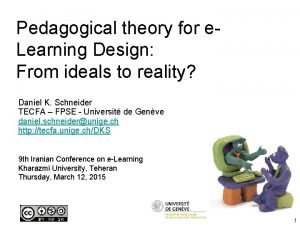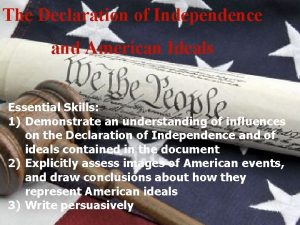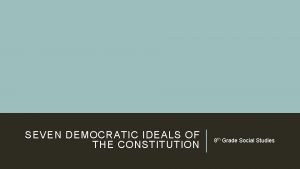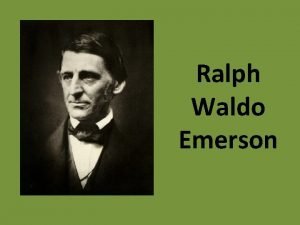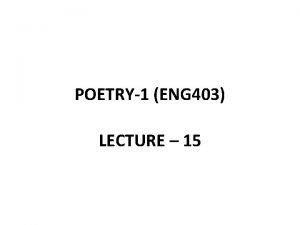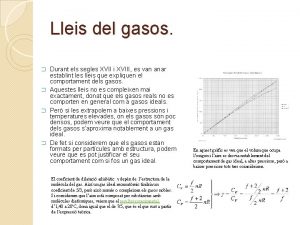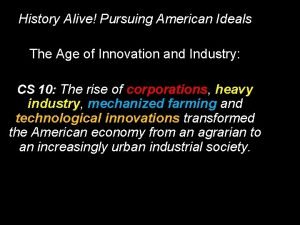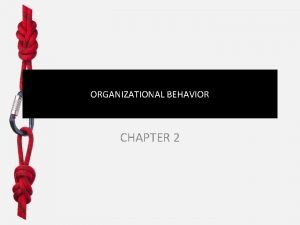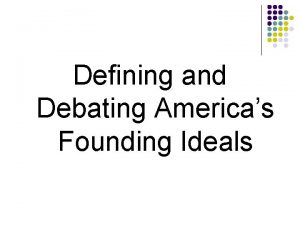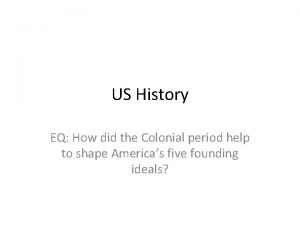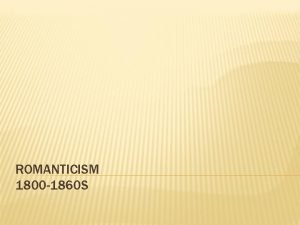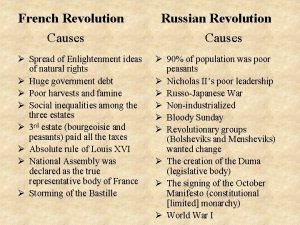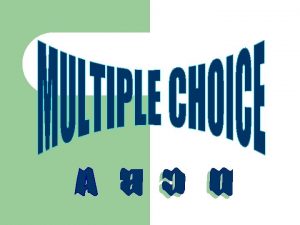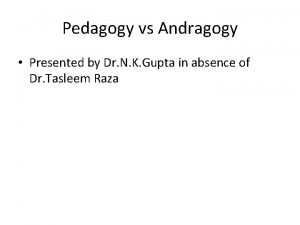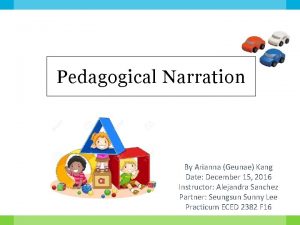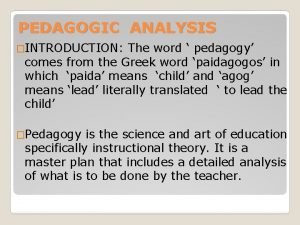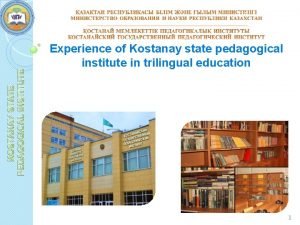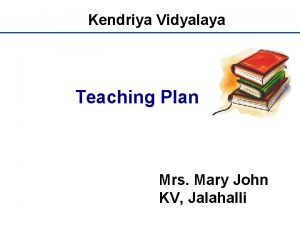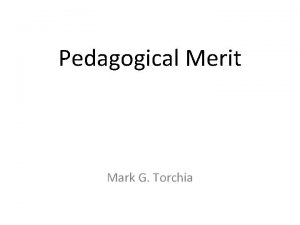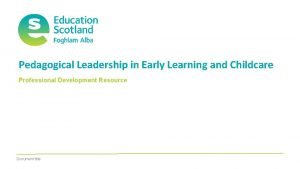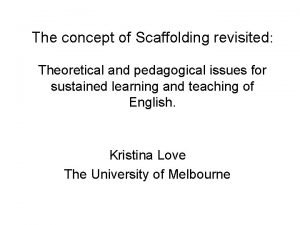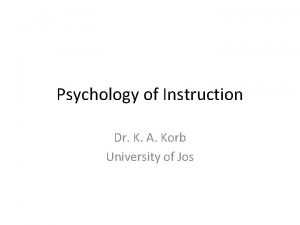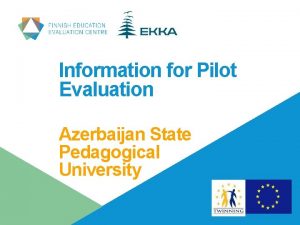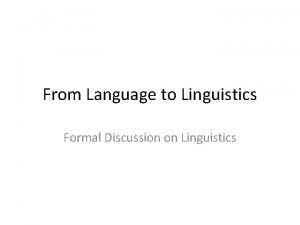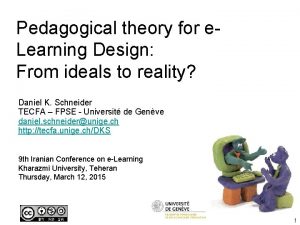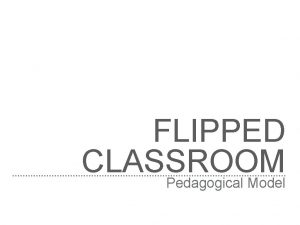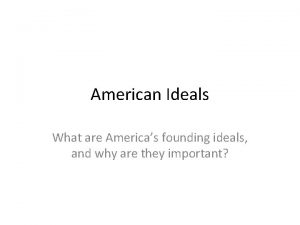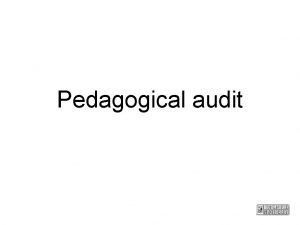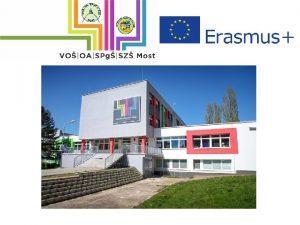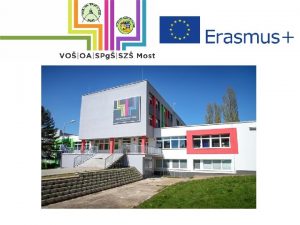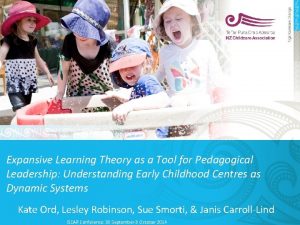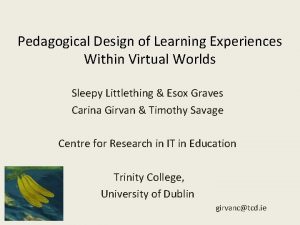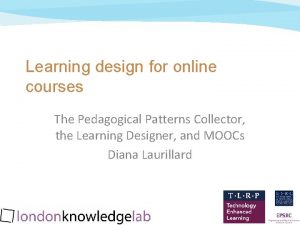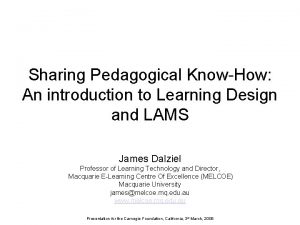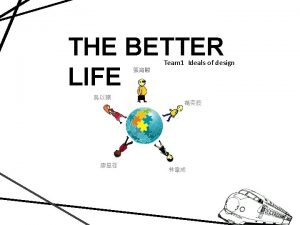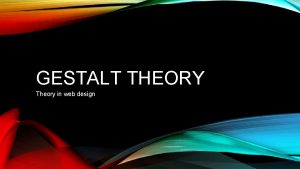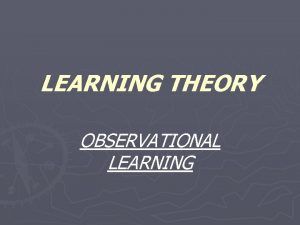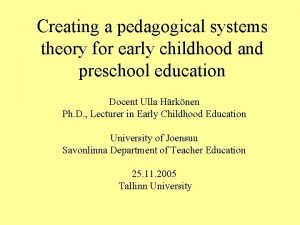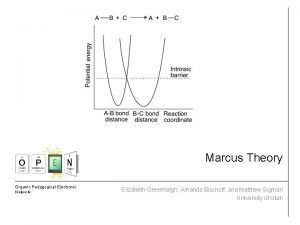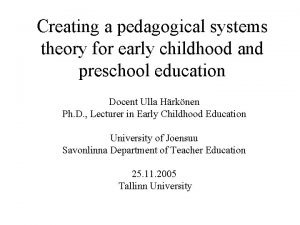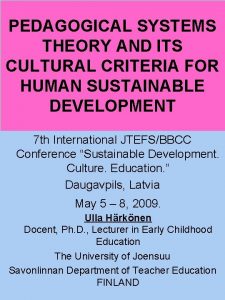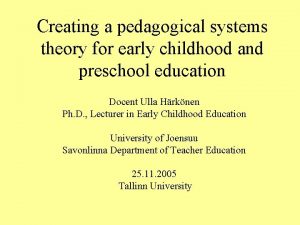Pedagogical theory for e Learning Design From ideals







































- Slides: 39

Pedagogical theory for e. Learning Design: From ideals to reality? Daniel K. Schneider TECFA – FPSE - Université de Genève daniel. schneider@unige. ch http: //tecfa. unige. ch/DKS 9 th Iranian Conference on e-Learning Kharazmi University, Teheran Thursday, March 12, 2015 1

Menu 1. What is e-learning ? 2. The role & evolution of technology 3. Educational principles – e-learning principles ? 4. People ? 5. E-learning and pedagogic change ? 10. 09. 2020 2

1. What is e-learning ? 3

E-learning (widely defined): Digital education Technology-enhanced learning ICT in education Other words to talk about the same subjet … Learning with technology Instructional technology Educational technology Academic fields of research & study … the study and practice of facilitating learning and improving performance by creating, using, and managing appropriate technological processes and 10. 09. 2020 resources. (AECT) 4

E-learning …. . Widely defined Distance teaching Knowledge creation Online collaboration Online course management Online tutoring e-Learning Electronic books … and much more Interactive multimedia Simulations and educational games • in distance teaching • in mixed (blended) teaching • in presence teaching Automated assessment Teleteaching through videos • in formal schools • in formal workplace learning 5 • for informal learning

E-learning is many things (again). E-Learning «topics» are: Cognitive tools for learning, computer-assisted language learning, computer-based assessment s e i g te computersystems, computer-based training, a r t ls a n mediated communications, tio computer-supported a c du e f o collaborative learning, distributed learning s n e z o D electronic performance support environments, s systems, interactive learning genvironments, e i lo o n interactive multimedia tsystems, interactive ch e f o s simulations andozgames, intelligent agents on the en D Internet, intelligent tutoring systems, microworlds, virtual reality based learning systems, MOOCs, …. 10. 09. 2020 6

Distance education Guidance / tutoring Quizzing/e-assessment contents administration Use of technology in different domains: Blended learning Prof. training Presence education OER, MOOCs, books Reality does not match potential: … quality could be improved … scope and richness could be expanded 9/10/2020 7

2. The role & evolution of technology 8

E-learning = A history of hype cycles The Hype Cycle is a branded graphical tool by Gartner Consulting for representing the maturity, adoption and social application of specific technologies. 2 - 25 years http: //en. wikipedia. org/wiki/Hype_cycle Technology, not pedagogy, triggers new cycles (mostly) Technology is the driving force, even if we do not like it … 10. 09. 2020 9

The technology hype curve in education (Hypecycle, 2014) Interactive tool: https: //hypecycle. umn. edu/ 10. 09. 2020 10

It is difficult to predict the future: Gartner etc. can be very wrong 2009: Gartner’s education hype cycle: «Podcasts/Edu cational TV are dead» But in 2014: Podcasts are central in (x)MOOCs ! 10. 09. 2020 11

E-learning - «Big inventions» about every 10 years • New administrative structures are created, • little communication between new and old structures • New people enter the game, no understanding of basic principles A huge diversity Computerbased training TV Edu games 1960 1970 Virtual Env. I CBL, micro-worlds simulations Intelligent CSCL tutoring 1980 1990 Virtual OER Env. II Analytics E-learning platforms 2000 Non-edu tools MOOCs 2010 2015 12

Change is usually very slow, sometimes it appears to be fast The x. MOOCs «tsunami» bundles other stuff… Open educational resources (OER) Educational broadcast (Edison ‘ 20) Educational TV Podcasts (i. Tunes) Teleteaching Computer quizzing (automated assessment) Khan academy (cool videos for kids) x. MOOCs Rapid e-learning (short videos for grownups) Collaborative learning Online communities 1920 Peer-to-peer assessment c. MOOCs (Downes & Siemens) 2008 2012 13

Before following the latest hype: Ask if it is compatible with sound instructional design principles ? …. with your ideals of teaching ? Look at past achievements of similar technology Analyse what a new technology can do (affordances for different pedagogies) 14

3. Educational principles – e-learning principles ? 15

Are there first principles of good elearning design ? Is there an «elearning theory» ? 16

First question: what is good education ? (M. David Merril) 1. The demonstration principle • Learning is promoted when learners observe a demonstration 2. The application principle • Learning is promoted when learners apply the new knowledge 3. The activation principle • Learning is promoted when learners activate prior knowledge or experience 4. The integration principle: • Learning is promoted when learners integrate their new knowledge into their everyday world 5. The task-centered principle • Learning is promoted when learners engage in tasks that lead to something http: //mdavidmerrill. com/Papers/firstprinciplesbymerrill. pdf 17

Second question: what can e-education “add” to education ? Activities are supported by tools (incl. digitized resources). Some activities can lead to tangible “products”, which can be discussed, evaluated, reused, etc. Products feed into activities Scenario 1 Activity 1 + Coordination / management tools Learner Products Activity 2 Product 1 Tool 2 Product 2 Tool 3 Product 3 Activity 3 Scenario 2 Activity 4 learning Tool 1 Activity. . 10. 09. 2020 (Videos, online text, blog, wiki, file upload, links manager, albums, glossary tool, calendar, forum, IM, project mgmt, databases, professional software, …) 18

The e-learning challenge – make it better (1) N participants 100’ 000 Videos x. MOOCs 10000 ? Online text. Books Distance E-learning with quizzes 1000 Find good strategies and tactics to improve quality while keeping costs stable ? ? Dist. elearning with activites & tutoring Teacher-led E-learning with activities 100 Classroom learning 10 low ? ? Blended learning ? ? high Richness & quality 10. 09. 2020 19

The e-learning challenge – make it better (2) Quality high medium low high N participants 10. 09. 2020 20

The bottom line from many meta studies: Quality is more important than type of design (good transmissive learning is better than bad constructivist) Ambitious strategies require “scripting” (who does what when with which resources) Most learners need (formal) challenge Education is design for learning (informal self-guided learning cannot replace formal learning) Learners need guidance and feedback E-learning is design for learning, enhanced with digital tools 10. 09. 2020 21

Adapt pedagogy to learning level / type high Know in action Know how Know that low Anderson & Krathwohl taxonomy (picture from Wikipedia) 10. 09. 2020 • Define learning objectives • Adapt teaching strategy & tactics to objectives 22

Strategies and technology must fit learning types and goals

Educational scenarios (learning designs) Define • who does what (tasks/activities) and when, • using tools and resources Compendium. LD (Learning design software) 10. 09. 2020 Scenarios = strategies & tactics made operational 24

Example: A strategy for facts and simple procedure learning 9 events of instruction (Gagné) 1. Gain attention (ground the lesson, motivate) • Present a good problem, a new situation, use a multimedia advertisement, ask questions… 2. Describe the goal (frame the information, create expectancies) • State what will be accomplished, how knowledge can be used, give a demonstration, . . . 3. Stimulate recall of prior knowledge (help connecting) • … facts, rules, procedures or skills relevant to the current lesson …. 4. Present the material to be learned • e. g. text, graphics, simulations, figures, pictures, sound, etc. Chunk information 5. Provide guidance for learning • Presentation of content is different from instructions on how to learn. Use of different channel (e. g. side-boxes) 6. Elicit performance "practice" • Practice skills or apply knowledge. 7. Provide informative feedback • show correctness of the trainee's response, comment learner's behavior, …. 8. Assess performance, test if the lesson has been learned. • Also provide general progress information 9. Enhance retention and transfer • Provide additional practice. Put the learner in a transfer situation, . . . 25

Example: Principles of inquiry-based learning n n n Elicit questions Experiment, observe, read. Compose Q & A Present / Discuss Reframe The crucial difference between current formulations of inquiry and the traditional "scientific method" is the explicit recognition that inquiry is cyclic and nonlinear. » n. Sandoval 2004 p. 216 http: //tecfa. unige. ch/perso/lombardf/publications/maastrich-14 -16 XI 07/ 26

Some strategies take time: Inquiry learning (Lombard, 2012) It takes about 3 month before there is some deep learning !! 250 Epistemic complexity of wiki page versions during an investigation (2007) Nombre d'items 200 150 50 22. 4% Descriptions-simples Simple descriptions Descriptions étayées Detailed descriptions Explications simples Simple explanations Explications étayées Complex explanations 76 34. 1% 9 25 68 30. 5% 29 13. 0% 100 50 0 0 2 13 24 5 1 10 27, janvier 12 h 27, janvier : 14 h 20 4. 5% 29. 5% 54. 5% 11. 4% 32 7 12. 7% 35. 2% 45. 0% 9. 86% 44 94 5, Février : 10 h 03 14, mars : 9 h 22 Progression de l'investigation : numéro de version et date (2007)

Tutoring structure and sentiment of presence Learners must be tutored • Break down learning activities into steps • Assign clear roles to tutors Learners must become part of a community. E. g. use: • chat sessions, • flipped classrooms • knowledge co-construction activities • sharable e-portfolios • peer commenting/tutoring/evaluation Failure rates: • MOOCS: 95% • Distance education with little tutoring: 60 -70 % • Distance education with tutoring and presence: 5 -20 % 10. 09. 2020 http: //edutechwiki. unige. ch/en/ 28

Good e-learning: …. . uses an appropriate pedagogical strategy aligned with goals, means and other constraints …. . creates active learning and active learners …. . Uses technology to enhance delivery, cognition, tutoring, collaboration, evaluation. etc Good e-learning technology: Supports educational strategies and tactics with appropriate tools 10. 09. 2020 29

4. People ? 30

Teachers should be trained in using techology for education TPACK = be able to create technology enhanced teaching designs (that include use/teaching of domain technology too) (Koehler & Mishra) TK, TCK, TPK and TPACK is missing from teacher education The TPACK framework (teacher development) 10. 09. 2020 http: //edutechwiki. unige. ch/en/ 31

The Net generation – students and teachers (I) 1% Rule: Only 1% of a community web site’s users are active Variants: 1 -9 -90 rule or 90– 9– 1 principle: Within a community: • 90% only view content, • 9% edit content • 1% actively create new content. http: //en. wikipedia. org/wiki/1%_rule_(Internet_culture) Wikipedia statistics (feb 2014) • 18 billion page views • 500 million unique visitors each month. • 22 million accounts • ~70, 000 active editors (0. 01 %) • ~7000 do half of the content (0. 001 %) 10. 09. 2020 32

The Net generation – students and teachers (II) Digital natives can: • … engage in digital conversation • … create simple digital objects (messages, videos, posts, …) • … exchange digital objects Digital natives cannot: • … use professional software • … participate in knowledge creation environments • … articulate or even follow scenarios 10. 09. 2020 Internet skills are conversational Full ICT and knowledge working skills must be taught (some of it can be enforced in formal education !) 33

Technology acceptance People tend to use a techno-pedagogy if it is: Useful (effective) Return on Investment (efficient) Usable Available (it must work) 10. 09. 2020 34

5. E-learning and pedagogic change ? 35

Innovation in schools ? Burkhardt and Schoenfeld, Educational Researcher (2003) • Model 1: Teachers read research and implement it in their classrooms: teachers neither have time nor skills • Model 2: Summary guides: not explicit, not enough • Model 3: General professional development: Long-term professional development for teachers can be effective. (Briars, 2001; Briars & Resnick, 2000). • Model 4: The policy route: diagnosis of causes is speculative, uses not effective time scales, etc. (Dillon, 2003). • Model 5: The long route: takes 25 years or more: productive dialectic between educational research and practice. • Model 6: Design experiments: Work, but can’t be scaled Time needed for school wide change= 25 years or more 36 Best unit for change is school … a system may need >100 years

Cost / Benefit E-learning offering the same quality as traditional teaching costs more ! Therefore, try reducing costs: Use standards Automatize what can be Reuse OER Have students contribute (materials, tutoring) 9/10/2020 Focus material production on difficult matters Use/repurpose domain tools, e. g. engineering software, online word processors, …. Peer-tutoring / commenting http: //edutechwiki. unige. ch/en/ Some ideas …. 37

Conclusion There is no universal e-elearning implementation theory, but some principles that are supported by empirical evidence Implementation community (e. g. a school) define empower create define Means Goals and learning outcomes constrain Pedagogic design principles & strategies Implement 10. 09. 2020 Technology infrastructure Teacher development 38

Thank you for listening Questions ? Comments ? http: //edutechwiki. unige. ch/ 39
 Pedagogical design for e learning
Pedagogical design for e learning Cuadro comparativo de e-learning
Cuadro comparativo de e-learning Ideals in the declaration of independence
Ideals in the declaration of independence 7 democratic ideals
7 democratic ideals Transcendentalist ideals
Transcendentalist ideals Puritan ideals
Puritan ideals Puritan ideals
Puritan ideals Jonathan edwards a puritan code worksheet answers
Jonathan edwards a puritan code worksheet answers Puritan ideals
Puritan ideals Constant gasos ideals
Constant gasos ideals History alive pursuing american ideals online textbook
History alive pursuing american ideals online textbook Puritan ideals
Puritan ideals There are people with gods and lofty ideals
There are people with gods and lofty ideals Personal attitudes affect behavior via intentions
Personal attitudes affect behavior via intentions Discovering american ideals in primary sources
Discovering american ideals in primary sources English bill of rights
English bill of rights Symptoms of poor delegation
Symptoms of poor delegation Declaration of independence dbq
Declaration of independence dbq Romantic ideals
Romantic ideals Enlightenment ideals
Enlightenment ideals Castiligione
Castiligione America's founding ideals
America's founding ideals Who reduced the ideals of animalism to the phrase
Who reduced the ideals of animalism to the phrase Andragogy vs pedagogy
Andragogy vs pedagogy Pedagogical translation
Pedagogical translation Pedagogical narration examples
Pedagogical narration examples Definition of pedagogical analysis
Definition of pedagogical analysis Kostanay state pedagogical institute
Kostanay state pedagogical institute Kendriya vidyalaya annual pedagogical plan
Kendriya vidyalaya annual pedagogical plan Pedagogy pronounce
Pedagogy pronounce Scottish school system
Scottish school system Nukus state pedagogical institute
Nukus state pedagogical institute Pedagogical scaffolding
Pedagogical scaffolding Pedagogical approaches to teaching math
Pedagogical approaches to teaching math Advantages and disadvantages of pedagogical analysis
Advantages and disadvantages of pedagogical analysis Azerbaijan state pedagogical university
Azerbaijan state pedagogical university Traditional grammar
Traditional grammar Kontinuitetshantering
Kontinuitetshantering Typiska drag för en novell
Typiska drag för en novell Tack för att ni lyssnade bild
Tack för att ni lyssnade bild
